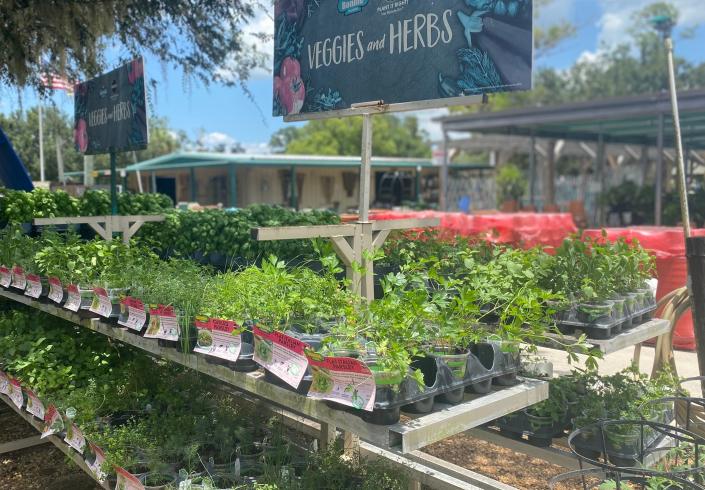If your homegrown herbs are fizzling failures, the problem might their friend group. You think I’m joking. Turns out, and this was news to me, herbs are like people. Just as we have friends who bring out the best in us and foes who bring out the worst, just as we know people who make us sweeter and keep pests away, as well as those who hog all the resources and zap our energy, the same is true for herbs.
This explains the mixed success I’ve had with the two 24-inch-round herb planters in my yard. I now have some insight into why my basil grew like gangbusters this summer but crushed the sage. So, per my usual learning style – fail first, then find out what went wrong – I sought help.
“Herbs have friends and foes,” said Bri Murray, a horticulturist at Lukas Nursery, in Oviedo, Fla., whom I cornered in the herb aisle this week. “Some hog water and root space, and push others away. Some want dry soil and have no tolerance for their soggy neighbors. Some will even change the flavor of their neighbors.”
Does everyone know this but me?
“Knowing which herbs get along and which ones don’t is important when planting your container garden,” she said, “because herbs that are friends can enhance each other’s performance, while enemies zap one another.”
Despite their playground antics, herbs are among the easiest plants to grow for beginner gardeners, and Murray is a big fan of the effort. “An herb garden taps so many of the senses,” she said. “You touch them, watch them grow, and, of course, smell and taste them.”
“If you don’t kill them first,” I say, as I peruse the unsuspecting baby herb plants for sale.
“It’s also a confidence booster,” she added, “because it’s gratifying, easy and cost effective.”
Cost effective? I don’t tell her about the time I spent $40 on the container, $20 on potting soil, and $30 on young promising herb plants, and netted three basil leaves.
“We paid how much for that caprese garnish?” my husband asked.
“I never promised you an herb garden,” I told him.
But when all does go right, growing and harvesting your own homegrown herbs is good for your soul, for your cooking, and for your ego. You get to say, “Oh, yes, the basil in my pesto came from the garden.” Pish, posh. “The mint in your iced tea? I grew that, thank you for asking.”
Before I left the nursery, Murray helped me select some compatible herbs to reboot my home herb garden. I think they are becoming friends.
Because a search on “companion gardening” (the term professional gardeners use to refer to this friend-foe phenomenon) will send you down a botanical worm hole from which you might never emerge, Murray offered these beginner tips for those who want to get their herb gardens off the ground:
· Get the dirt. Start with a container that is at least six-inches deep with a drainage hole in the bottom. Fill it with good quality indoor-outdoor potting mix. You can create your herb garden from seed or from starter plants, but in summer starting with young plants is best, Murray said. Spring is a good time to start herbs from seed.
· Indoors or out? The beauty of an herb container garden is that it’s portable. You can put it outdoors, indoors, or on the patio, so long as it gets sunlight. When the weather turns cold, move the container indoors by a window.
· Know the friend groups. A search online will help you determine which herbs to pair, and which to split up. One guideline is water preference. Oregano, rosemary, thyme, and sage live well together because they like dry soil. Basil, parsley, and dill like a wetter environment, which is why my basil grew at the expense of my sage.
· Seek out positive influences. Like good friends, basil makes parsley sweeter, while parsley brings out basil’s flavor, Murray said. Oregano can act like the pest police because its peppery scent keeps harmful insects away.
· Some don’t play well with others.Mint tends to take over, so does better in a pot of its own. “It gets aggressive, and makes other plants stress out,” she said. The same is true of fennel, which is so overpowering it can actually change the flavor of nearby herbs.
· Cut the flowers. For more flavor and fuller plant growth, nip flowers in the bud. If you let flowers blossom and go to seed, the plant will spend its energy on reproducing and not on producing flavorful leaves.
· Up your game. If you want your herb garden to both thrive and look pretty, plant not just according to personality but also according to shape. For instance, when creating a dry-loving garden, put a tall herb like rosemary in the center, surround it with a lower lying filler like sage, then plant a cascading herb like oregano or thyme around the edges.
· Savor the flavor. As any chef knows, herbs fresh from the garden taste better than those packaged in the store. Plus, you can’t beat the flavor of those bragging rights.
Marni Jameson is the author of six home and lifestyle books, including “What to Do With Everything You Own to Leave the Legacy You Want,” “Downsizing the Family Home – What to Save, What to Let Go,” and “Downsizing the Blended Home – When Two Households Become One.” You may reach her at marnijameson.com.
This article originally appeared on Sarasota Herald-Tribune: MARNI JAMESON: How do herb gardens grow? By making friends, of course








